CAST
John Adams...................Ben Franklin...............Thomas Jefferson
John Dickinson............Edward Rutledge..............The Courier
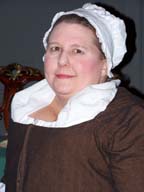
Richard Henry Lee...........Martha Jefferson...............Abigail Adams
Robert Livingston...............Roger Sherman.............Secretary Thomson
Andrew McNair.............Leather Apron..............John Hancock
James Wilson.............Dr. Lyman Hall...............Joseph Hewes
Lewis Morris...............George Read.................Caesar Rodney
Col. Thomas McKean...........Samuel Chase..............Stephen Hopkins
Dr. Josiah Bartlett......Rev. Jonathan Witherspoon.............The Painter
PERFORMANCE DATES November 12, 13, 2004 at 8:00; November 14, 2004 at 2:30; and November 18, 19, 20, 2004 at 8:00
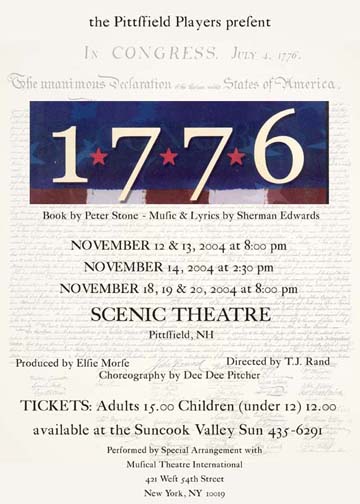
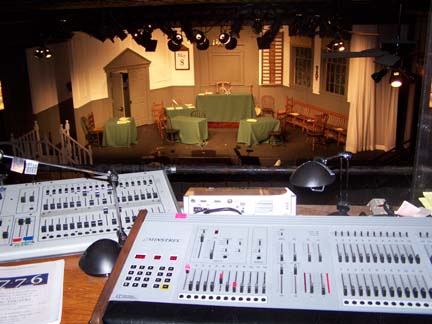
CAST OF CHARACTERS
.Click on character name for more information including costume plot, photo of completed costume, audition photo, head shot and cast bios. Those with an (*) have comments by the cast member.
President
John
Hancock
New Hampshire
Dr.
Josiah Bartlett
Massachusetts
John
Adams *
Rhode Island
Stephen
Hopkins *
Connecticut
Roger
Sherman
New York
Lewis
Morris *
Robert
Livingston
New Jersey
Jonathan
Witherspoon
Pennsylvania
Benjamin
Franklin
John
Dickinson
James
Wilson
Delaware
Caesar
Rodney *
Col.
Thomas McKean
George
Read
Maryland
Samuel
Chase
Virginia
Richard
Henry Lee
Thomas
Jefferson
North Carolina
Joseph
Hewes *
South Carolina
Edward
Rutledge *
Georgia
Dr.
Lyman Hall
Other
Charles
Thomson, clerk
Andrew
McNair, custodian
A
Leather Apron
Courier
*
Abigail
Adams *
Martha
Jefferson
LINKS
Detailed Costume Items - WIGS - HATS - BUTTONS
Chronology - Chronological list of events relating to production by the Director
Portraits and signatures of the Signers
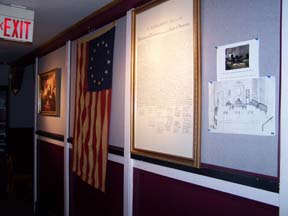
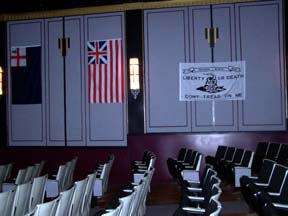
The Scenic Theatre was decked out with some interesting items for the performance of '1776'. Among them were the following:
A simulated oil painting of the Trumball portrait of the signers of the Declaration of Independence.
A copy of the engraving of the Declaration of Independence, which was done on order of President John Quincy Adams, who noticed the original was beginning to fade.
The Betsy Ross flag.
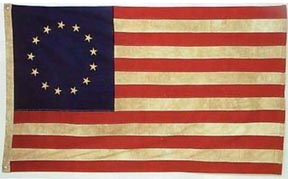
Legend
has it that Betsy Ross, who made flags for the Philadelphia Navy Board, made the
first U.S. flag for George Washington. It had thirteen five-pointed stars in a
circle.
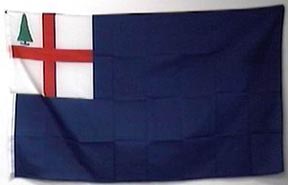
The "Bunker Hill Flag" with the blue field was an error made by a person coloring flag charts a couple of hundred years ago. The flag, representing New England, was correctly printed with heraldic hatching to indicate a red field, but it was colored blue by mistake. That one error has lived to this day as fact. The report by the North American Vexillological Association in the 1970's concluded that the Americans probably didn't carry any flag at Bunker Hill, they were such a rag-tag outfit. The most famous painting of the battle shows a flag with the red field with green pine tree in a white canton, no cross. Unfortunately, the British flag in the same painting has the St Andrew's cross in blue on a red canton, or some such mish mash. So the artist may not have been all that careful about his rendition of the New England flag. The same flag but with a circle of stars in the field is a copyrighted design by a company in Essex, Massachusetts, and is to represent the New England States.
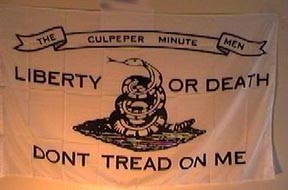
The Culpeper flag is somewhat doubtful historically. It only dates to Lossing's 19th Century book on the American Revolution and there isn't any documentation about it otherwise. Also, there are no colors as it was illustrated as a line drawing. Also, Lossing says the Culpeper Minute Men used it but also says they were active 1776-77, so 1775 date not supported at all. There is supposed to be a contemporary account of this flag, but it cannot be found.
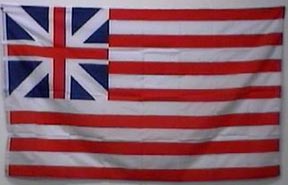
The famed "Grand Union" flag hoisted near Washington's headquarters at Cambridge on 2 January 1776 turned out to be exactly the same as the flag that the East India Company had used ... on the other side of the world ... since 1701. The design is essentially a red ensign (minus, of course, the X of St. Patrick at that time) with the red field divided into 13 red-and-white stripes: the same pattern as the later U.S. flag, once the canton changed to "a new constellation."